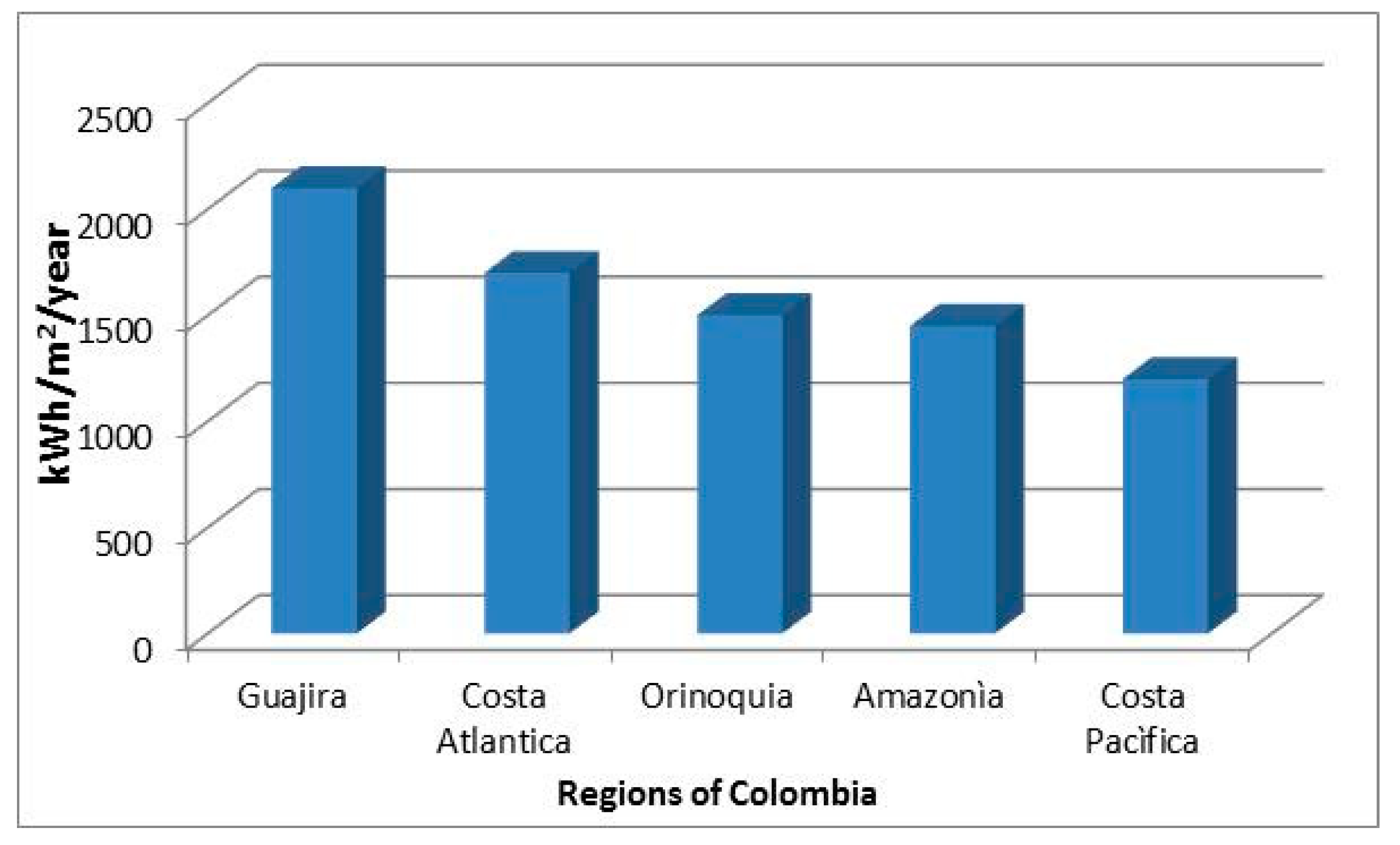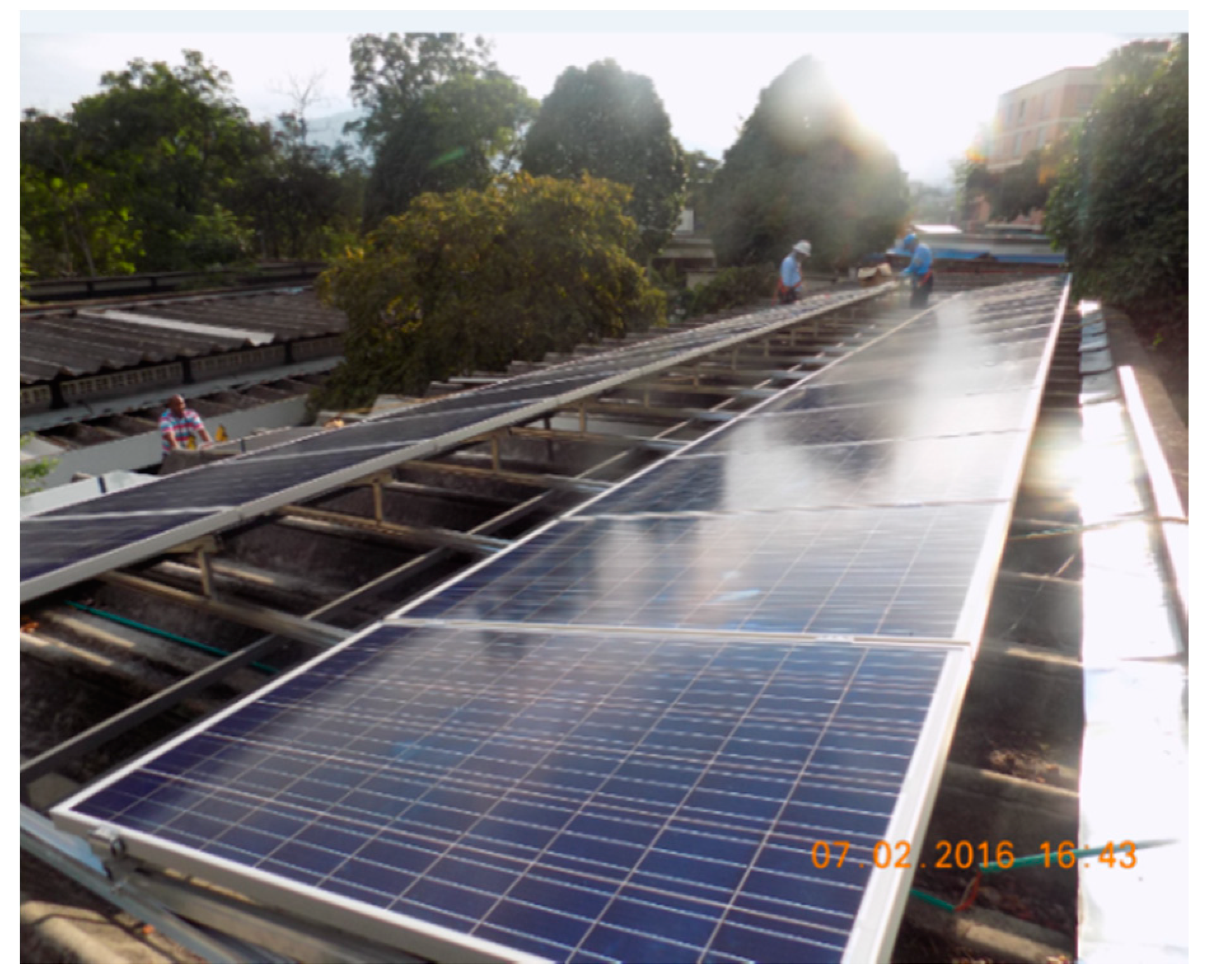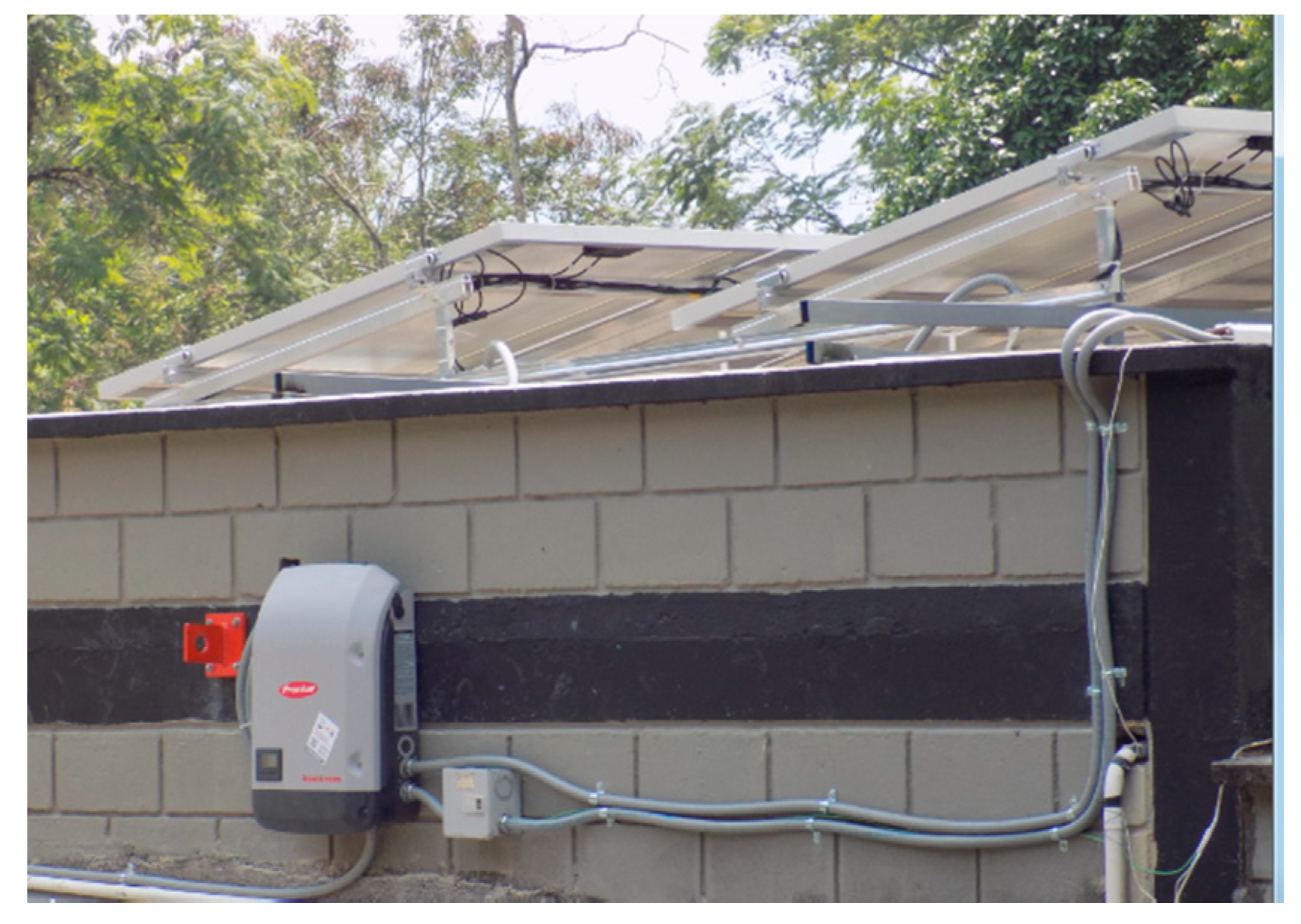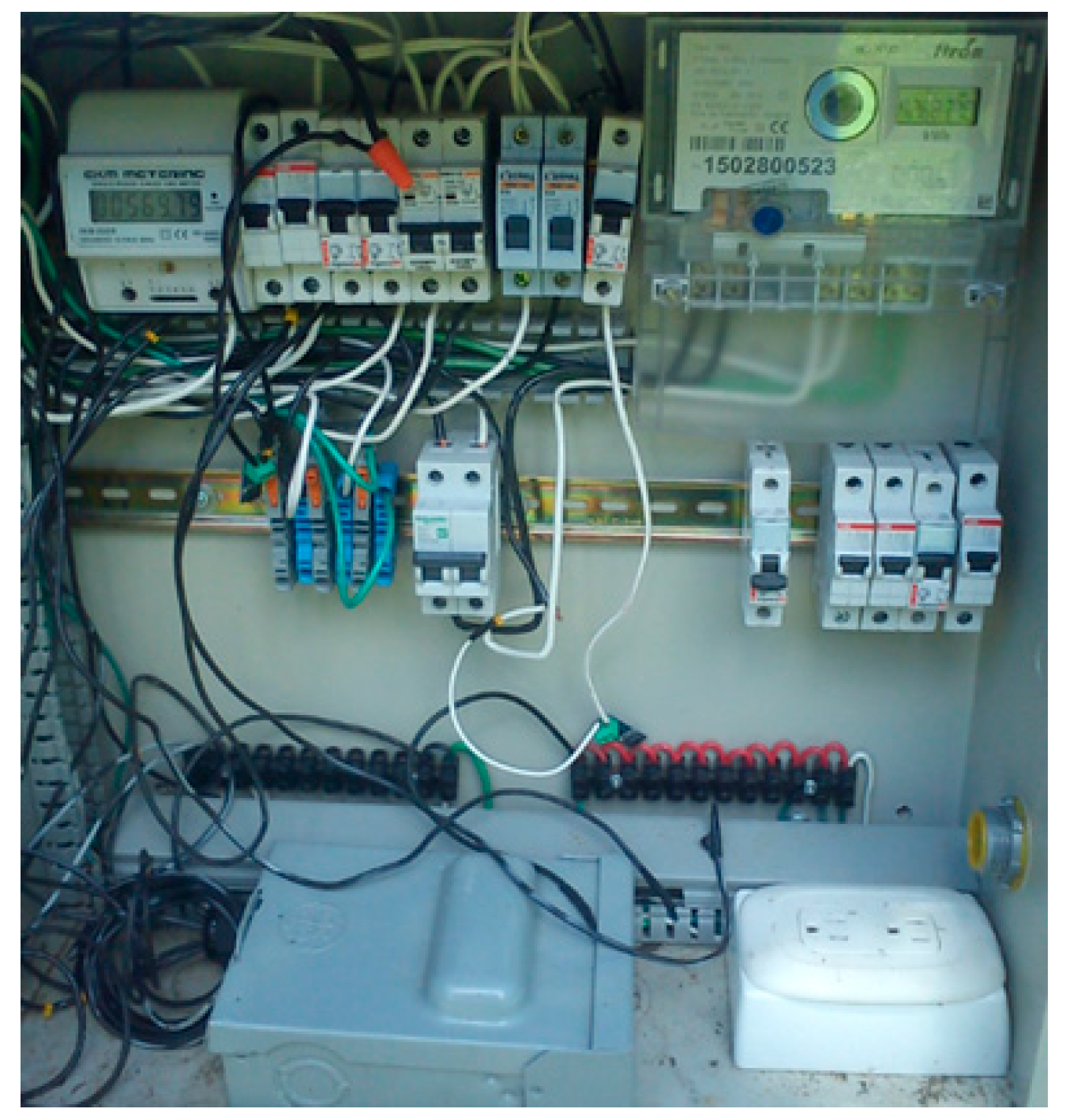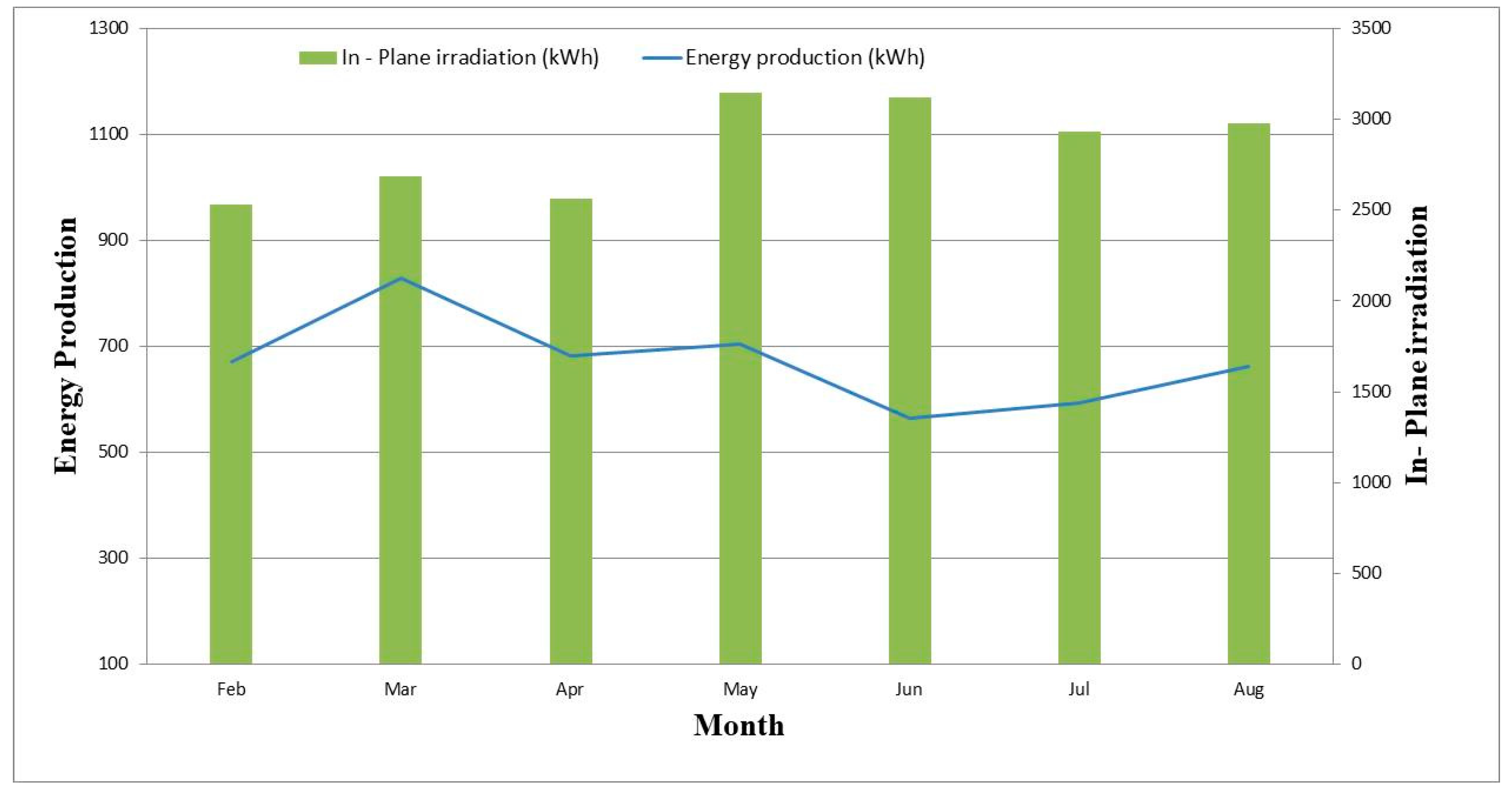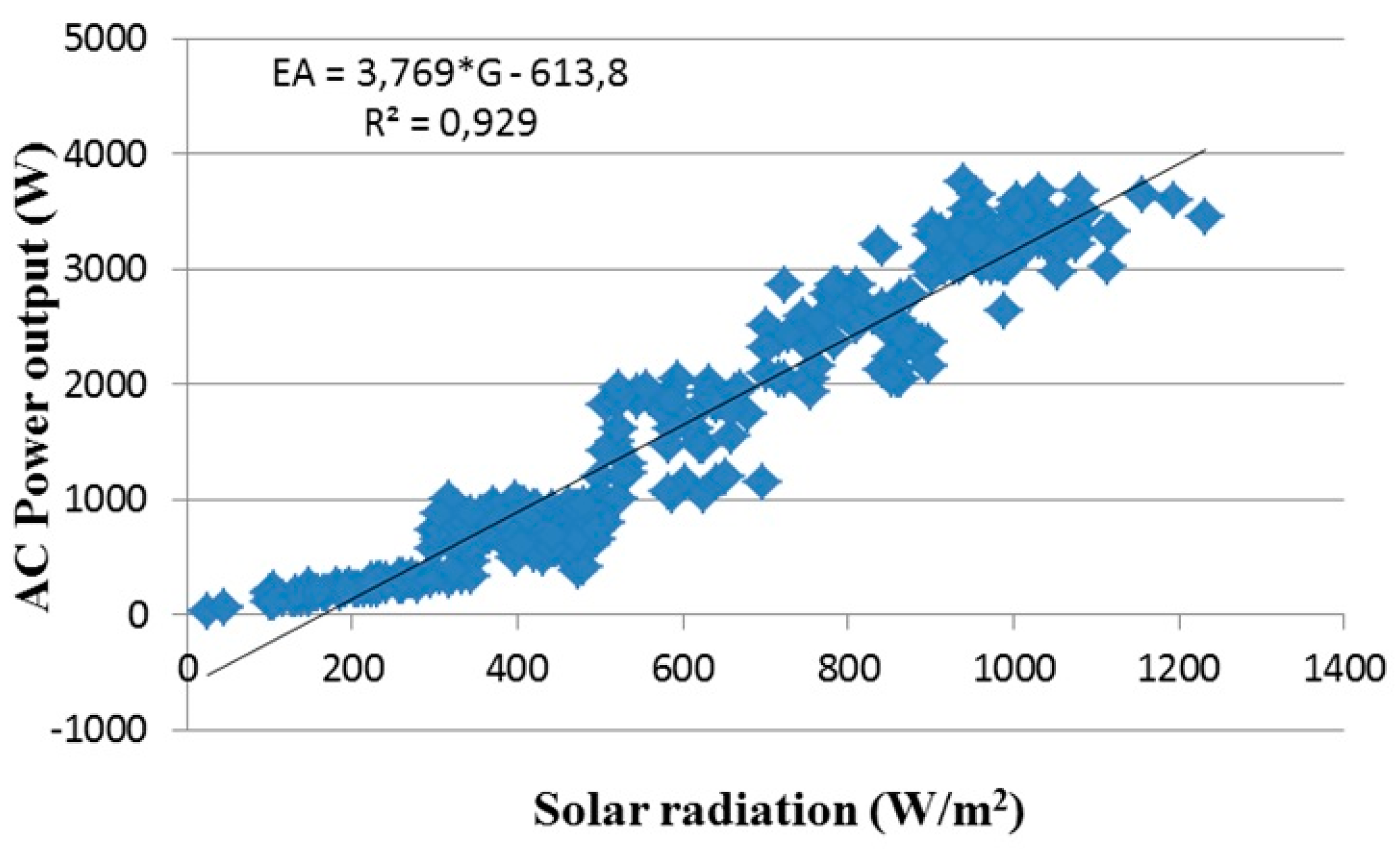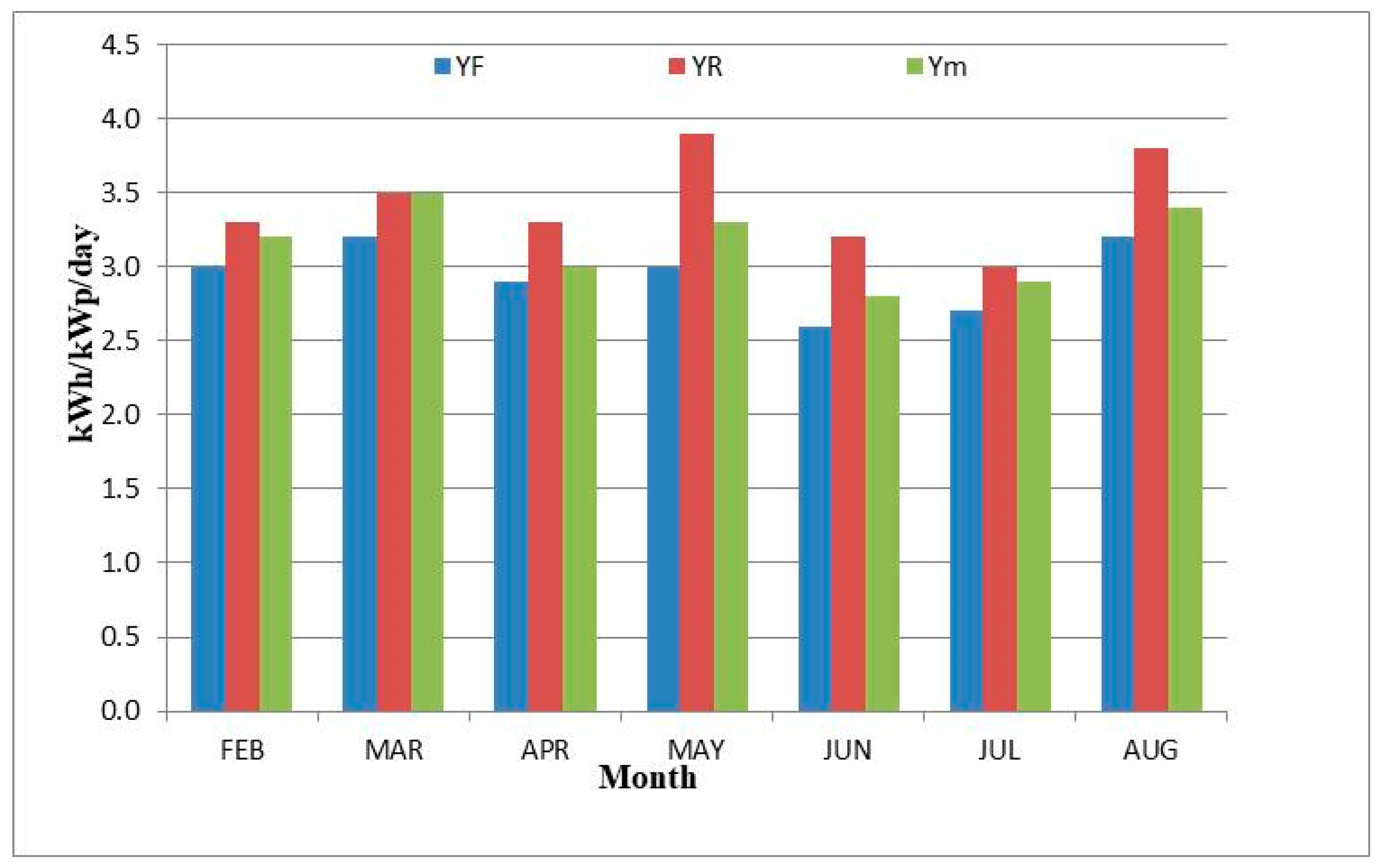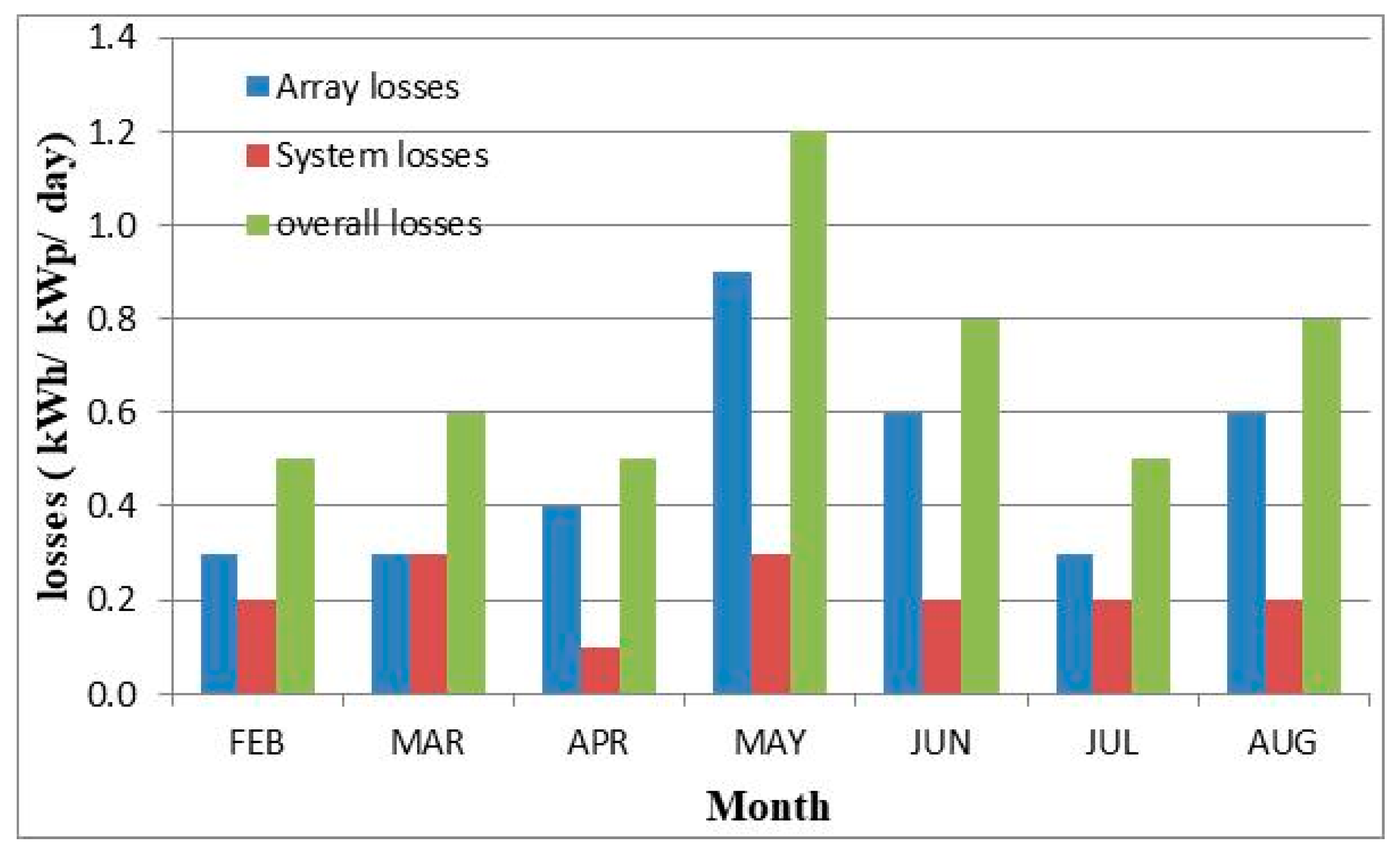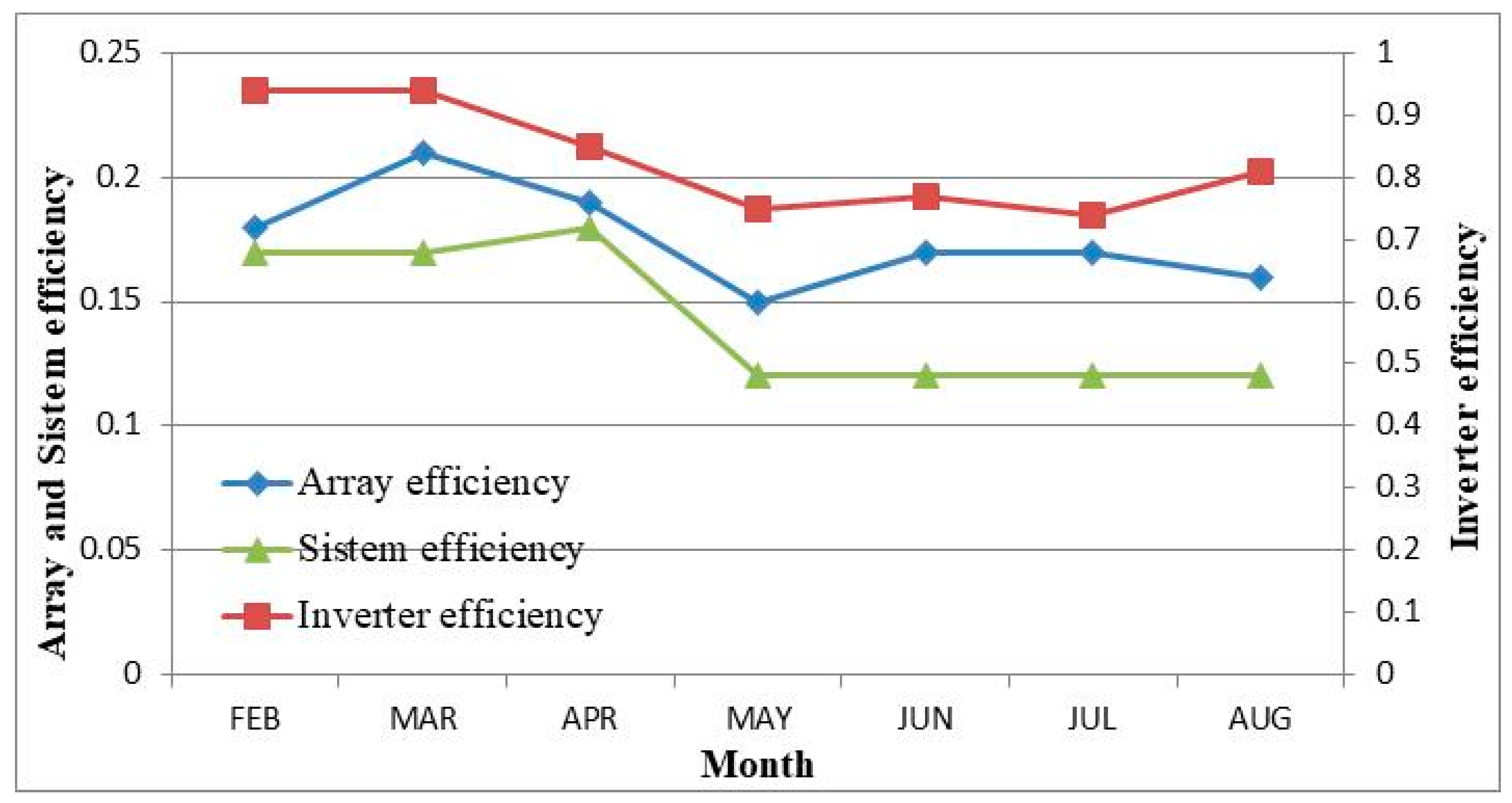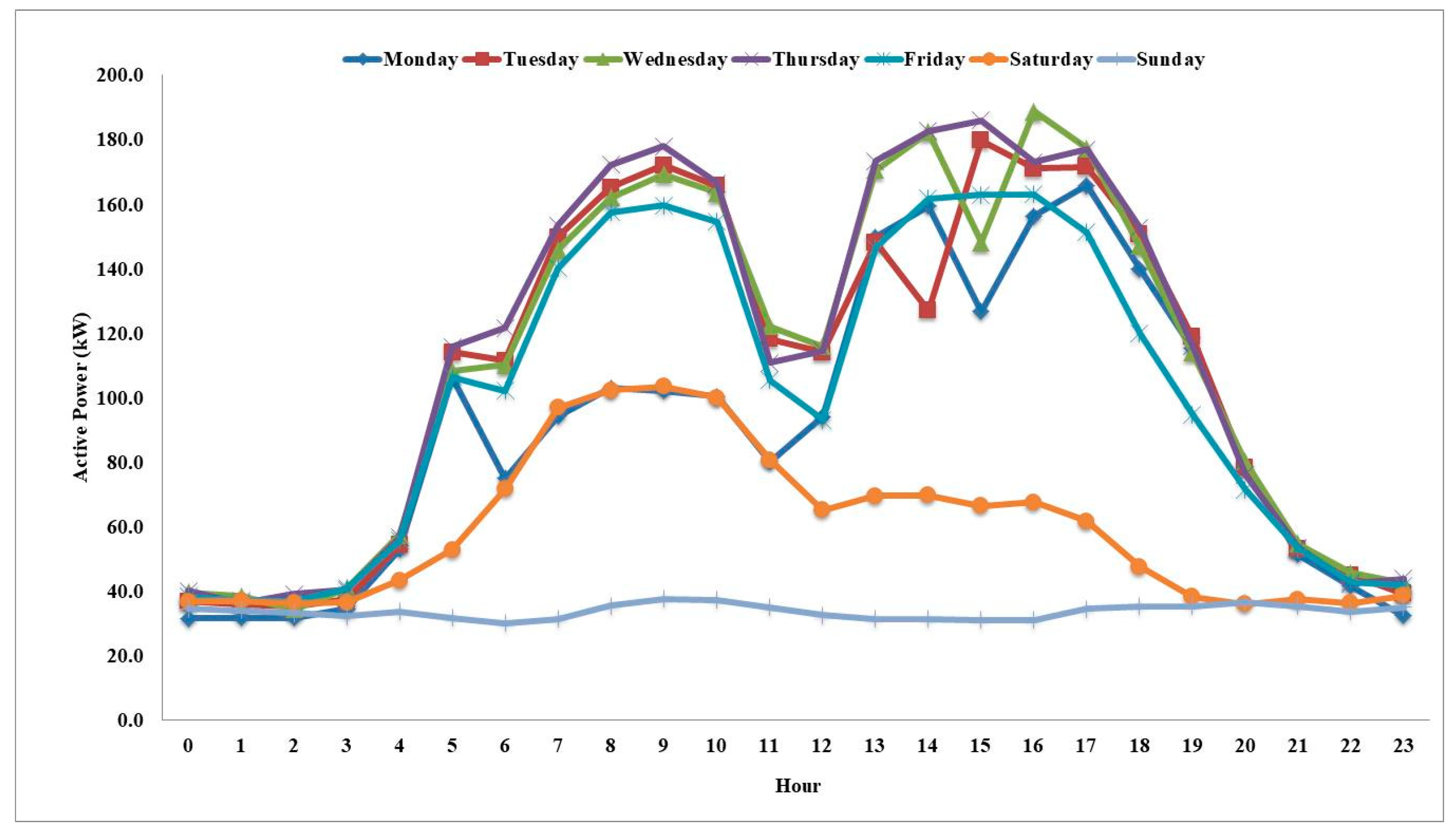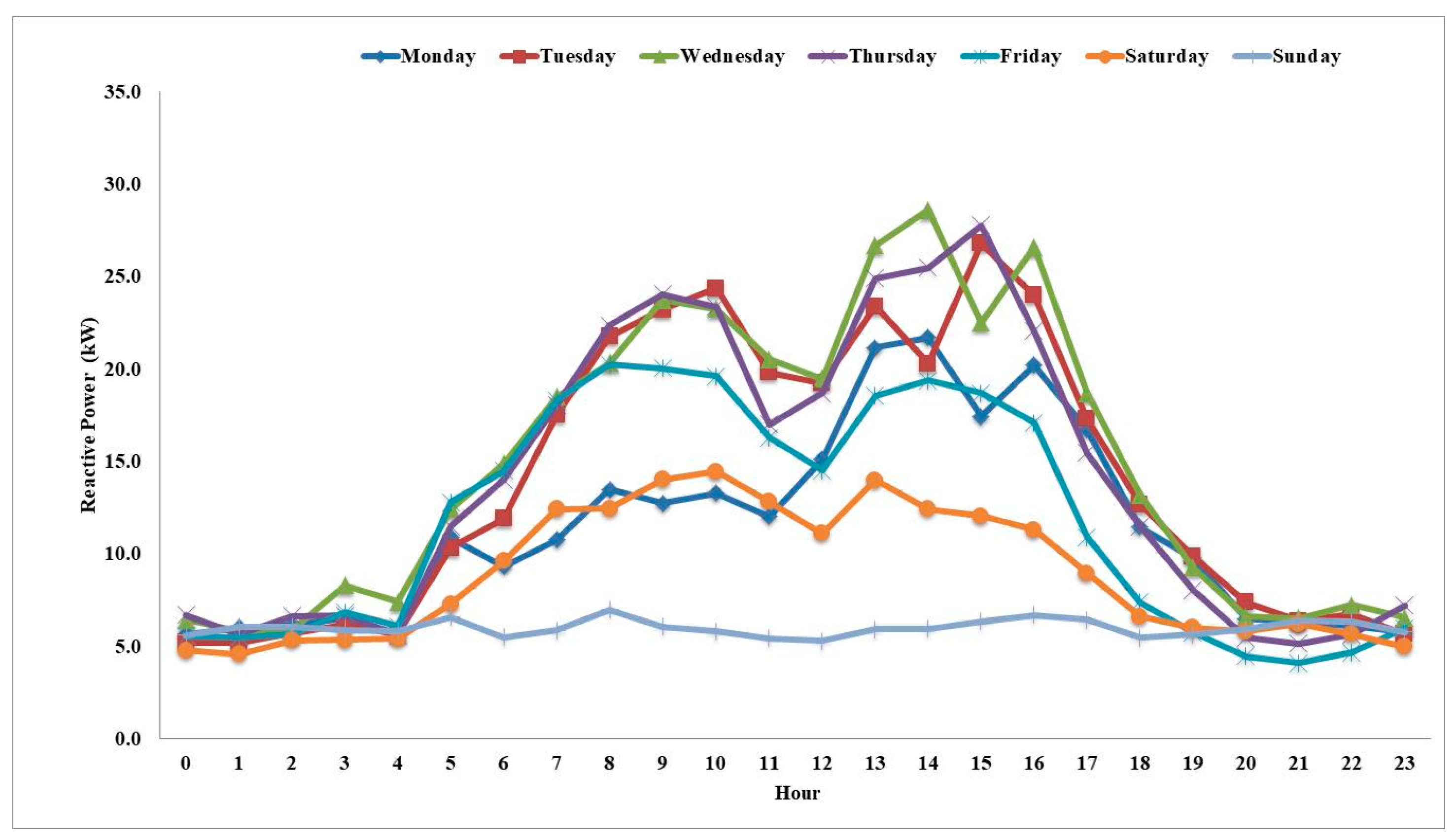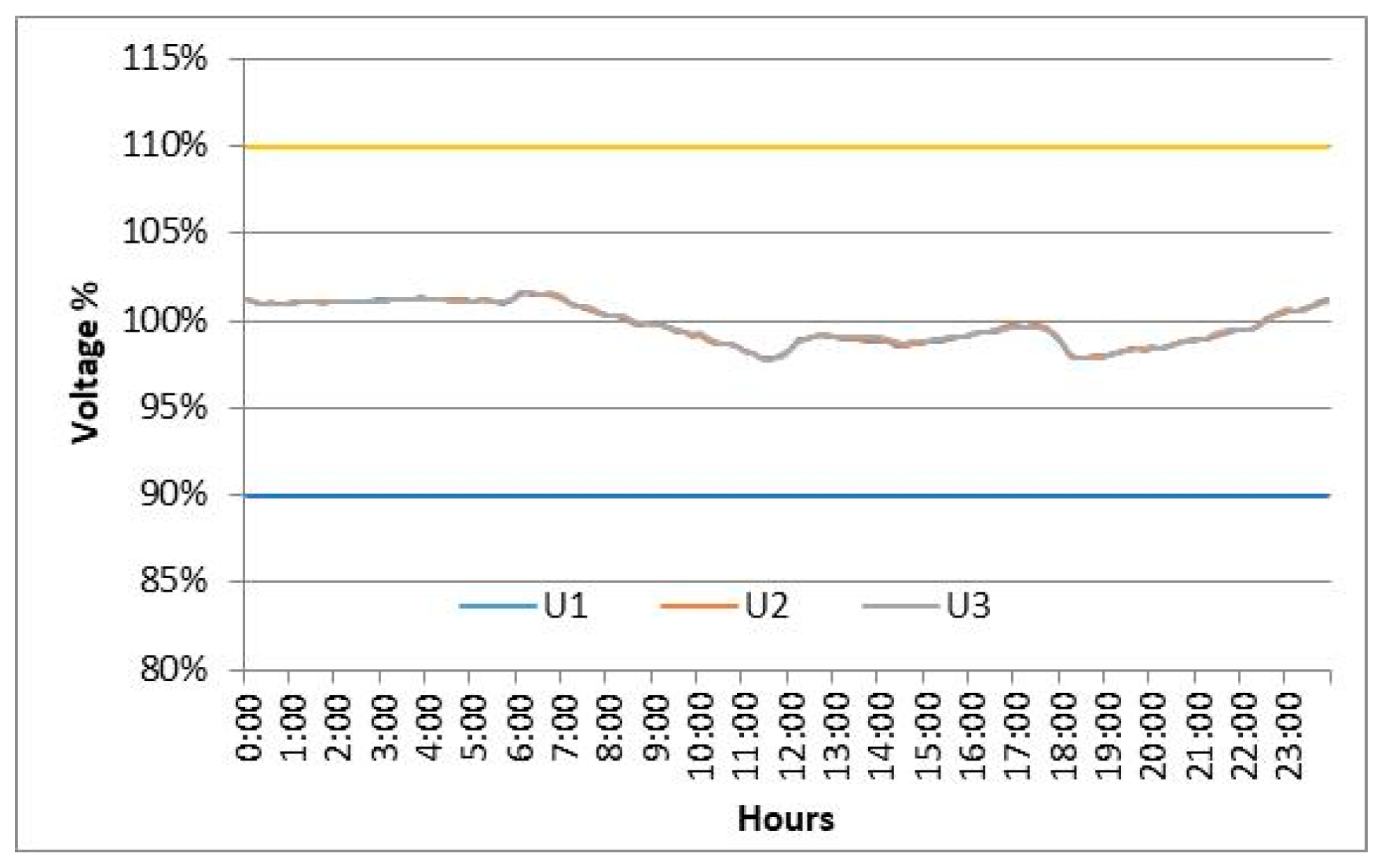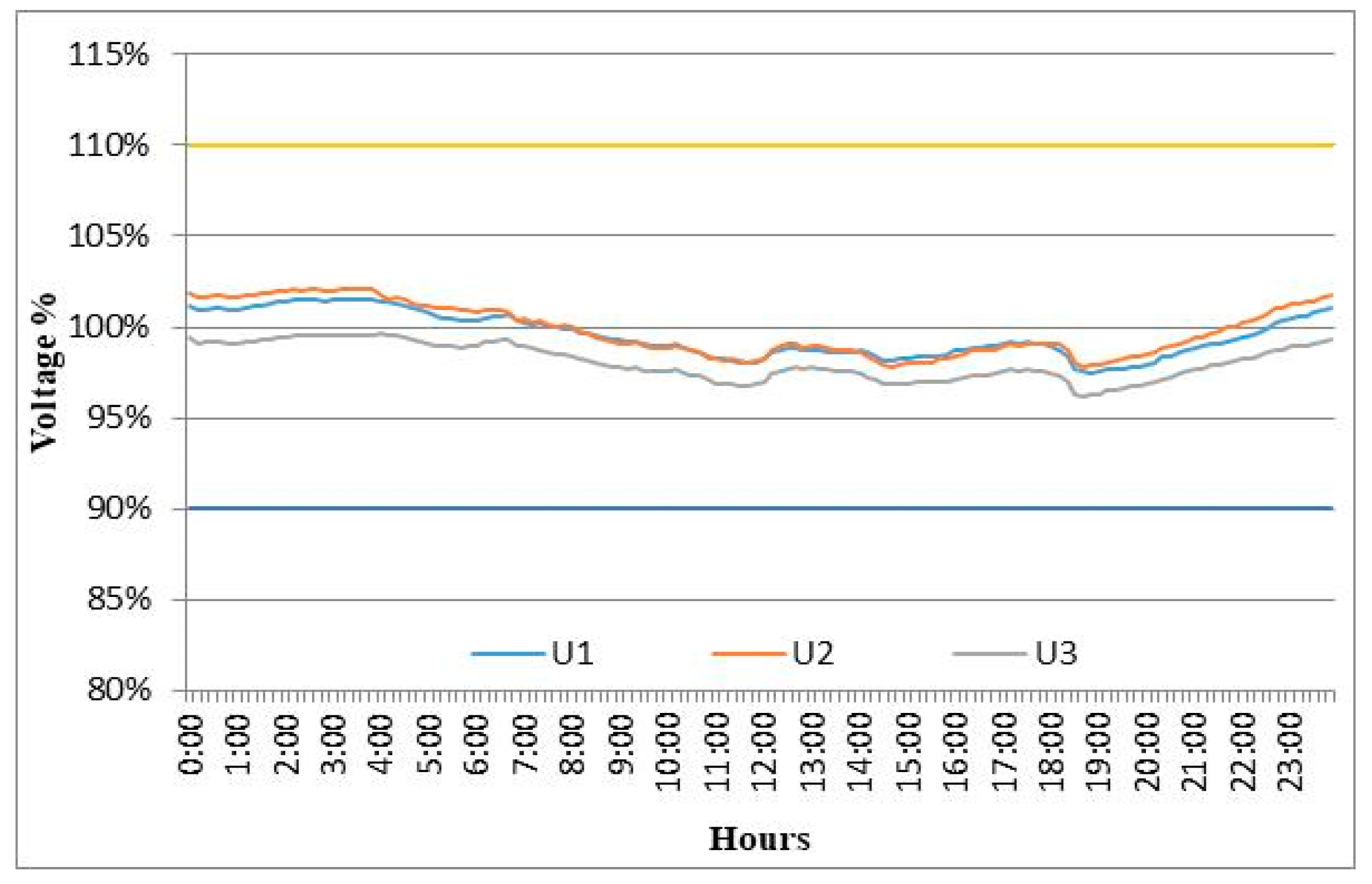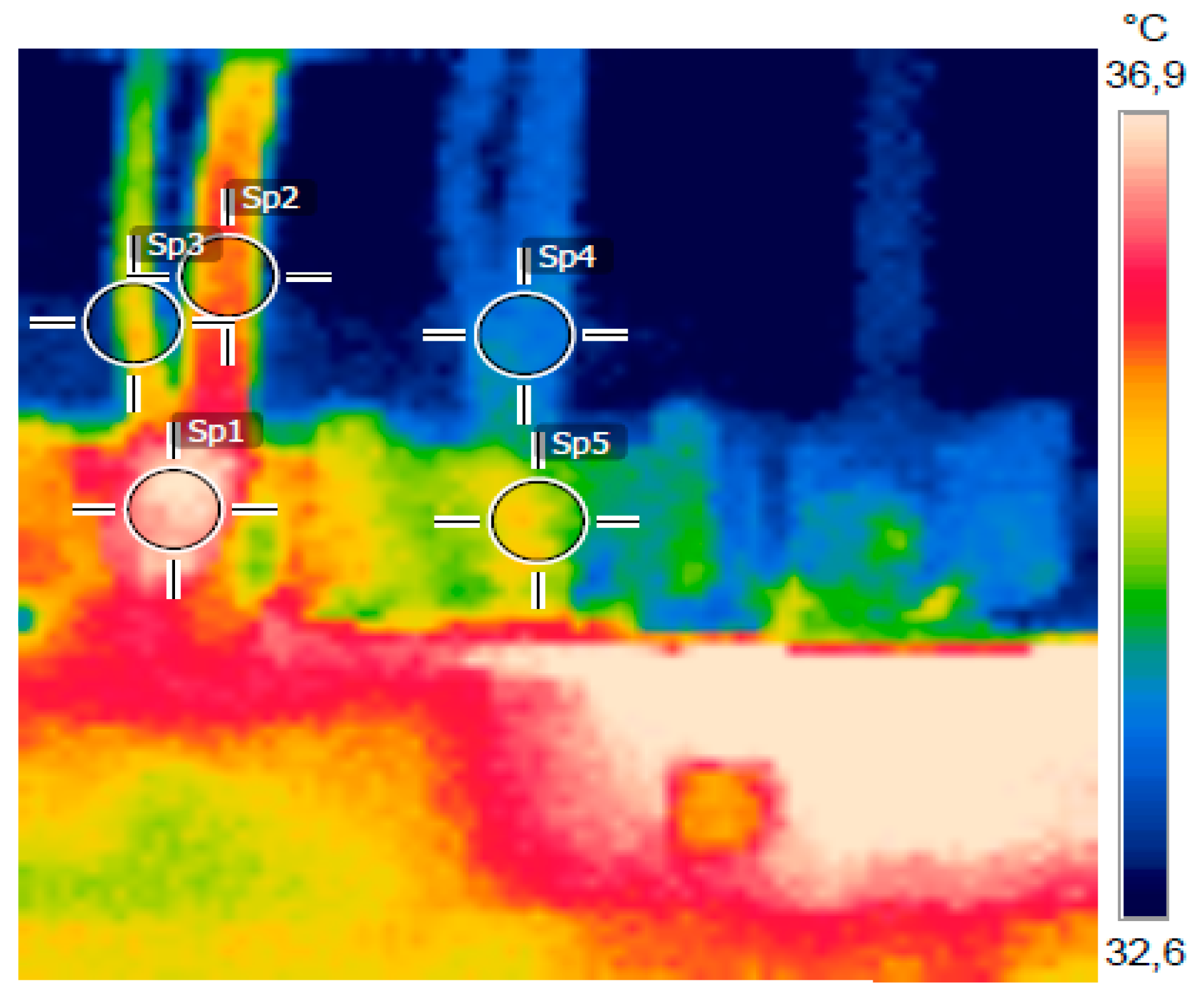1. Introduction
In response to the increase in energy demand and environmental restrictions on greenhouse gas emissions around the world, attention is now focused on renewable energy sources. Solar energy is considered an unlimited resource, so it could contribute to reduce the use of fossil fuels and their negative impacts. Moreover, it is considered more environmentally-friendly [
1], safer, noise-free and easy to install [
2]. Photovoltaic systems (PV) are manufactured using semiconductor materials such as silicon, which converts the incident radiation into electricity. This process is carried out directly and instantaneously, without complicated mechanical components [
3] with maximum efficiencies reached in the range of 12–15% [
4], in the case of commercial polycrystalline silicon cells.
Likewise, the PV industry and the market have grown rapidly in recent years, the main reason being the reduction of the generation costs and government policies that promote the introduction of PV systems connected to the grid. However, this growth has not been followed by developments in the field of failure diagnosis, monitoring and detection in PV systems, particularly in power outputs smaller than 25 kWp [
5], a procedure that allows one to establish the state of a PV installation, the efficiency with which it is operating, as well as its behavior against climatic variables, such as ambient temperature, solar radiation and wind speed.
The International Energy Outlook (IE) indicates that energy consumption will increase by more than 28% in 2015 (6.06 × 10
26 kJ) to 2040 (7.76 × 10
26 kJ) and predicts that there will be a significant increase in the consumption of coal reserves in the next 20 years. This institution suggests that, in order to achieve a contribution to global energy demand and a significant impact on pollution reduction, renewable energy sources should grow in such a way that, by the year 2050 they will become more than half of the world’s energy needs [
6]. According to the Renewable Energy police Network for the 21st Century (REN21), the contribution of renewable energy to global energy generation is 16%. The so-called new renewable energies, which include photovoltaic generation, contribute 0.6% [
7].
It must be added that interconnected photovoltaic systems are being used as a complement to conventional energy generation in many countries [
8,
9]. Applications range from a small power generation in remote areas in the past 25 years to the installation of centralized stations with large photovoltaic generation capacity scale. In recent years, a great interest in urban consumers has been generated as a distributed generation application, where plants with small generation capacity are installed on the roofs of buildings or residences within the Building Integrated Photovoltaic Systems (BIPVS) concept. Nowadays, there is a variety of hybrid energy solutions for building applications [
10,
11,
12,
13], and especially ones with the integration of photovoltaics [
14,
15,
16]. Their implementation mostly depends on the climate, geographical location, building type and on the availability of the energy resources on site. Despite the promising potential, one of the most important problems of PV systems is the dimensioning of its components, because, if a PV system is not correctly dimensioned, it does not work as expected [
17].
Therefore, the sizing of grid-connected photovoltaic systems (GCPV) involves two main procedures, namely the technical sizing procedure and the economic sizing to determine the expected technical performance indicators and the economic performance indicator of the proposed system. In technical terms, the estimation of the energy produced by a GCPV is a widely studied concept [
18,
19,
20,
21]; we can find, based on various approaches to design-based software recently introduced, [
22] methods and models for simulation to simplified calculation methods [
23,
24].
Currently there are online calculation methods that web pages of different organisms display, such as Joint Research Center (JRC) [
25]. The design of the photovoltaic system connected to the low voltage grid (GCPV) of 7.8 kWp in this case of study was carried out following the recommendations by [
26,
27,
28] with regard to the system evaluation, studies have been carried out in Europe and worldwide on the performance of photovoltaic systems operating outdoors as reported by [
29,
30,
31,
32,
33,
34,
35].
On the behavior of the power quality at the point of common coupling (the low voltage network and a distributed generation system), many authors propose some possible solutions. Marnay [
36], proposed a control strategy to control the voltage imbalance, the total harmonic distortion and the voltage gaps or SAGS, caused by large non-linear and unbalanced loads. Li et al. [
37], suggested the use of a series-parallel converter to control the voltage imbalance and the current demand in the case of a fault in the network. A converter consisting of three single-phase inverters to control unbalanced and non-linear loads is proposed by [
38,
39]. Papadimitriou et al. [
40] suggest that the imbalance of power, during the transition of the micro-grid from the mode connected to the disconnected can be restricted with a fuzzy and Zamani control et al. [
41] proposed a closed-loop control strategy that allows the micro-grid to maintain a good power quality without changing the modes.
Although Latin America has a high potential for the use of photovoltaic energies [
42], it lacks such studies. The performance evaluation of photovoltaic systems involves the calculation of the following parameters: annual energy generation, reference performance, final yield, system losses, loss of cell temperature, photovoltaic module efficiency, capacity factor and yield ratio among others [
32]. The results obtained provided useful information to policymakers and organizations interested in the actual performance of grid-connected photovoltaic systems in a region or country [
43].
Colombia has abundant natural resources, including a high-water potential, gas, coal, wind resources, solar energy and biomass. It is also located in an area of high geological activity that would make geothermal exploitation possible. One of the main difficulties is the lack of detailed information on the true potential of non-conventional renewable energy sources.
In general, the whole territory of Colombia has a good solar energy potential, with a daily average insolation of around 4.5 kWh/m
2 (La Guajira Peninsula, with an average value of 2.200 kWh/m
2/year can be highlighted) (
Figure 1). Although Colombia has favorable legislation for alternative energies, the costs of implementation of photovoltaic systems compared to other energy sources remain high, with current costs of 2100 USD/kWp, only exceeded by geothermal generation at 2200 USD/kWp and higher than hydroelectric power plants with costs of 1300 USD/kWp, coal-fired power plants of 800 USD/kWp, thermoelectric plants with combined cycle gas with 900 USD/kWp, wind power plants at 1200 USD/kWp and cogeneration 500 USD/kWp. However, due to the low operation and maintenance costs of photovoltaic systems, these can surpass coal-fired power plants and combined-cycle gas-fired thermoelectric plants, making them an excellent alternative to be included in the Colombian energy matrix.
In 2014, Colombian government signed law 1715 which established the legal framework for the promotion and exploration of non-conventional energy sources, mainly from renewable sources, the promotion of investments, research and development of clean technologies in energy production. Experimental studies are needed to solve the problems of voltages caused by photovoltaic systems, since experimental data can show the actual behavior of the system.
Thus, all the technical problems (voltage, power, synchronicity, flicker and frequency) originating at the point of common coupling between the grid and the photovoltaic system should be thoroughly studied before its implementation. In this paper an evaluation of a photovoltaic system of 7.8 kWp, connected to a point of common coupling of a low-voltage grid, located in the city of Ibagué (Colombia) was carried out. Besides that, in this paper we present the behavior of the power quality at the common point of connection between a distributed generation system and a low voltage grid in a tropical region. This work is organized as follows:
Section 2 describes the system and shows the evaluation parameters based on standards for Colombia.
Section 3 explains the methodology of Colombian Technical Standard NTC 5001 for measurements in the energy quality studies. Following this, we present the instruments for the measurement in
Section 4.
Section 5 summarizes our results (system efficiency, power quality and thermography analysis), while
Section 6 offers the conclusions.
2. Description of the Photovoltaic System Connected to the Low Voltage Grid
The experimental photovoltaic system has operated from February 2016 to date. It is located in block 3 at the Universidad de Ibagué at 1285 above sea level, latitude 4°26′54″ N, longitude 75°11′56″ W. The structure is made of I-beams of AISI 1045 steel, whose slope was calculated to be 12.3°, as shown in
Figure 2, The system consists of 30 panels tilted at a fixed angle of 14° and oriented towards the north with an azimuth of 4°, it is divided into three modules with 10 IBC PolySol 260-CS polycrystalline silicon panels each (Colombinvest, Bogotá, Colombia,
Table 1), which are connected in series covering an area of 49.1 m
2. A Fronius Primo 7.6-1 inverter (Colombinvest, Bogotá, Colombia,
Table 2) with a rated maximum efficiency of 96.9% and maximum AC power of 7600 W is also part of the circuit, as well as the Itron ACE300 bidirectional counter (Colombinvest, Bogotá, Colombia), which measures the data about the total energy generation.
Moreover, the sizing ratio, which represents the ratio between the PV array installed capacity and the inverter capacity, in the present case, is 1.0. Data is recorded in 1 min intervals and processed by a computer. Solar radiation, wind speed and ambient temperature were provided by an automatic Meteorological Station (100 m away from the PV system) at the Universidad de Ibagué, Colombia.
2.1. Performance Parameters
In order to evaluate the performance of a photovoltaic system connected to the low voltage grid, parameters of the IEC 61724 standard are taken as a reference: output energy, yields (Reference, Array, Final), array and system losses, Efficiencies (Array, System, Inverter) [
29,
30,
31,
32,
33,
34,
35]. These standardized performance parameters are relevant because they provide a basis by which grid-connected photovoltaic systems can be compared under various operating conditions [
29].
2.2. System Efficiency
The yields indicate the actual operation of the modules relative to their rated capacity; they can be classified into three types: array performance (
Ym), final (
YF) and reference (
YR) [
29]. The array performance (
Ym) is defined as the output direct current (DC) of the photovoltaic array over a period of time, divided by the nominal power. Other authors represent it as the time, measured in kWh/kWp, that the photovoltaic modules must operate at their nominal power to generate the energy produced [
44]. It is represented by Equation (1):
where
ED is the energy output of the photovoltaic module in (kWh), and
PPV the nominal power of the array in kWp.
The final yield (
YF), defined as the total energy (
EA) generated by the PV over a period of time divided by the nominal output power (
PPV) of the installed system [
45], is given in Equation (2):
The reference yield (
YR) is a measure of the theoretical available energy at a specific location over a period of time, corresponds to the total in-plane irradiance (
GT), divided by the reference irradiance (
GR) under conditions of Standard temperature which is 1 kW/m
2, obtained with Equation (3):
The modules capture losses (
Lm) which are the difference between the reference yield (
YR) and the array performance (
Ym), it represents the losses due to the operation of the modules that demonstrate the inability of the system to fully utilize the available irradiance [
46]. They are obtained by Equation (4):
The inverter losses (
LI) due to the conversion from DC power output to AC power in PV solar panels. They are given by Equation (5):
The efficiency of a PV system can be grouped into three categories: the photovoltaic module efficiency, system efficiency and inverter efficiency. The photovoltaic module efficiency (
), is the relationship between the daily output power (
ED) and the total daily irradiation product in the (
GT) plane and the area of the photovoltaic array (
Am) [
46]. PV module efficiency is calculated by the Equation (6):
The system efficiency (
) represents the performance of the entire PV system installed and is calculated by the Equation (7) and the inverter efficiency (
) by the Equation (8):
2.3. Power Quality
Power quality is needed to check the physical properties of the systems, such as amplitude, frequency, waveform, current and voltage. The most important standards for Colombia are: Electromagnetic Compatibility (IEC 61000-4-7, 2002), Recommended Practices and Requirements for Harmonic Control in Electrical Power Systems (IEEE 519, 1992), Energy Quality (NTC-5001, 2008)), Nominal Voltage and Frequency of Electric Power Systems in Service Networks (NTC-1340, 1998), Regulatory Commission for Energy and Gas (CREG 070,1998; 096, 2000; 084, 2002; 0024, 2005), and finally, the Technical Regulation on electrical installations (RETIE).
6. Conclusions
A study of a photovoltaic system of 7.8 kWp connected to the low voltage electrical grid belonging to the Universidad de Ibagué Colombia, from February to August 2016, determining its performance parameters and the energy quality at the common point of connection, is reported. The total energy produced was 8069.4 kWh and the final energy produced during the period divided by the nominal power of the system is 1034.5 kWh/kWh. The benchmark performance, module performance and final performance values ranged from a minimum to a maximum of 3.0–3.9 kWh/kWp/day; 2.8–3.5 kWh/kWp/day and 2.6–3.2 kWh/kWp/day, respectively. The average annual losses in the module, inverter and total losses were 0.5 kWh/kWp/day, 0.20 kWh/kWp/day and 0.7 kWh/kWp/day. The average monthly efficiency of the modules, the system and the investor during the registration period are 17.6%, 14.3% and 82.8%, respectively. Reactive power consumption increased between 7% and 40%. The voltage unbalance registers an increase of 3.5% and 70% with respect to the maximum and minimum values, respectively. The maximum and minimum value obtained during short and long duration flicker measurements was 0.35 p.u., 0.20 p.u. and 0.10 p.u., 0.09 p.u., respectively. The values of total voltage harmonics (THD) increased by 7% for the U1 line, 0.8% for U2 and 3% for the U3 line, and TDDI current harmonics recorded a 22% increase. The total active and reactive power were increased by 58% and 42% after the photovoltaic system started operating and the temperature at the common point of connection increased by 7%. The results show the importance of this type of study, because the vast majority of low voltage grids in Colombia are old, they are saturated and any disturbance can cause serious damage to the connected electrical devices. It is important to know the impact on the power quality caused by the installation of photovoltaic systems to the low voltage grid, in order to define the requirements of the network, the type of communication between the photovoltaic system and the operator of the low voltage grid, the necessary protection system, among others.
